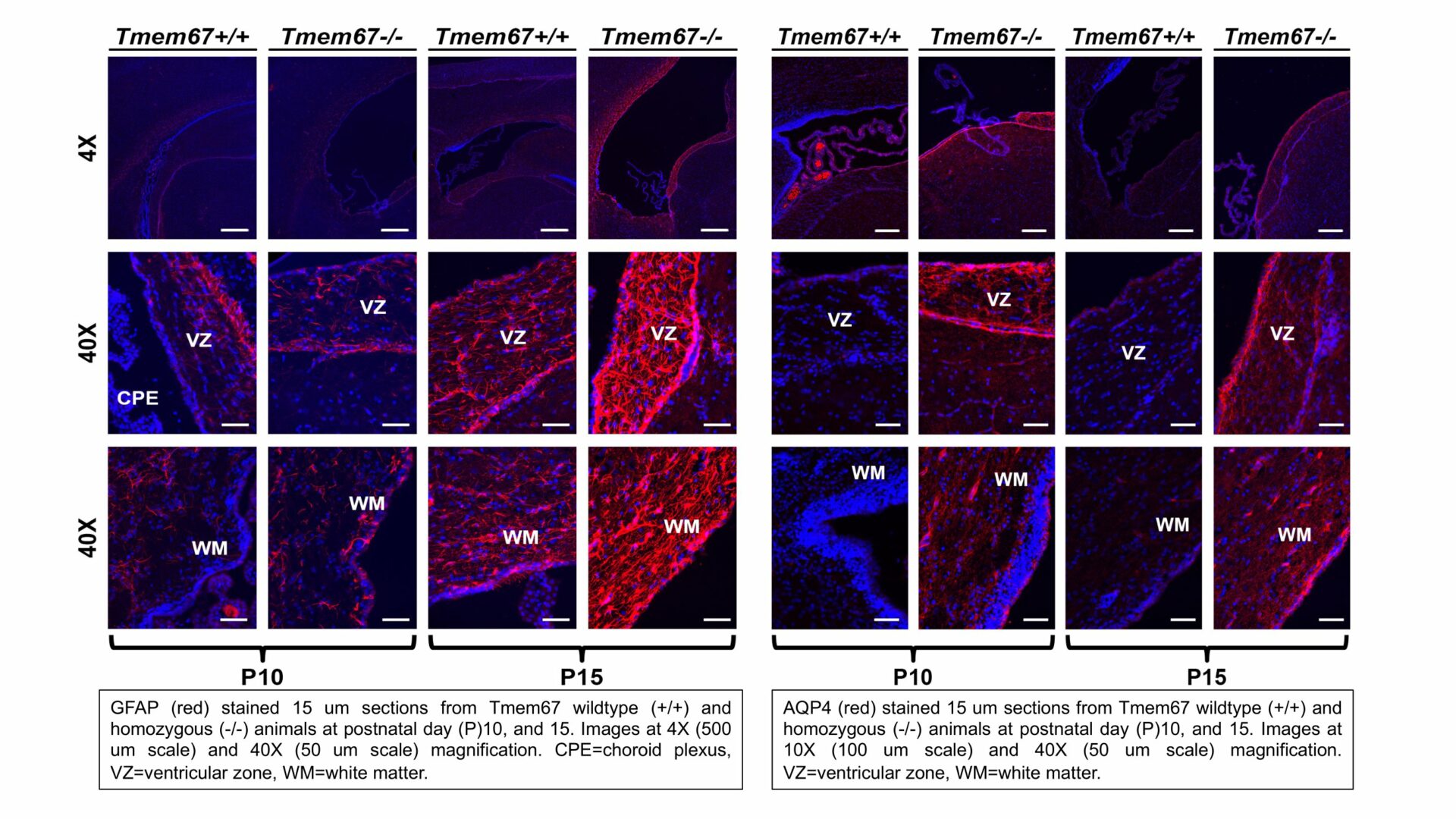Hydrocephalus is a result of cerebrospinal fluid (CSF) accumulating in the brain’s ventricles caused by imbalances in CSF secretion, flow, and/or absorption. Treatments for hydrocephalus include invasive procedures such as surgical shunt placement, which commonly fail and are revised throughout a patient’s life1. Taking a cell and molecular approach to characterize changes occurring during hydrocephalic development may lead to novel targets for pharmacological treatment.
Cell types associated with the blood-brain, brain-CSF, and blood-CSF barriers may be altered in hydrocephalus. This study focuses on choroid plexus epithelial (CPe) cells, ependymal cells, and astrocytes. The choroid plexus is a contiguous layer of tightly regulated epithelial cells surrounding a fenestrated capillary network that is responsible for the production of CSF. The ependymal cells are ciliated neuroglial cells that line the ventricles of the brain and play roles in CSF maintenance and waste clearance. Astrocytes are glial cells that perform various functions in the brain, one of them being blood-brain barrier regulation2. These cells serve in brain fluid/electrolyte regulation, an important component of barrier integrity. These cells contain aquaporins (AQP), AQP1 in the CP, and AQP4 in ependymal cells and astrocytes, that are important in regulating CSF and brain interstitial fluid. Aquaporins are implicated in various diseases associated with brain fluid regulation3.
In Wistar rats, a missense point mutation in the Transmembrane 67 (TMEM67) protein, causes a ciliopathy resulting in hydrocephalus4. Using this model, changes in barrier integrity and aquaporins were evaluated using immunohistochemistry, real-time quantitative polymerase chain reaction (RTqPCR), and western blot. Animals were euthanized using 1ml/kg body weight intraperitoneal injection of Euthasol (pentobarbital sodium 390mg/ml, phenytoin sodium 50mg/ml) or carbon dioxide gas according to the IUPUI IACUC protocol, then decapitated. Brains were harvested and processed for their respective experiments. Ventriculomegaly appears in TMEM67 homozygous animals before postnatal day (P)10 by quantitative magnetic resonance imaging5 and visualized with Nissl (n=3). Barrier integrity was investigated by examining glial activation and tight junction expression and appearance. Increased glial fibrillary acidic protein, a marker of astrocytes, appeared in hydrocephalic animals by immunohistochemistry as early as P10 (n=3). Fluorescent intensity of the tight junction proteins expressed in CPe; claudin-1 and 2, and adherens junction protein; E-cadherin, increased in P15 hydrocephalic animals compared to wildtype (n=3). Interestingly, P10 wildtype animals appeared to have more claudin-1 labeling than hydrocephalic animals (n=3). Expression will be confirmed using western blot (n=3).
Aquaporin localization was examined in hydrocephalic animals at P15, 10, and 5 (n=3). Increased fluorescent intensity of AQP4 in the subventricular zone of hydrocephalic and AQP1 apical localization in the CP was observed in hydrocephalic animals at P15 and P10. RTqPCR showed increased AQP1 in CPe5 (*p=0.0101) and no change in AQP4 mRNA in the periventricular cortex (p=0.4359) of P15 hydrocephalic animals compared to wildtype. Post-transcriptional changes will be evaluated using western blot (n=3).
These results provide further characterization of the role of the brain barriers and aquaporins in the pathophysiology of hydrocephalus and elucidate how brain fluid regulation may be altered in hydrocephalus. They also produce targets for pharmacological development.

